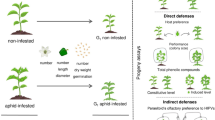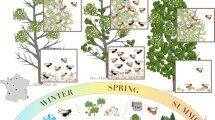Abstract
The presence of a natural enemy in a habitat refuge is no guarantee of emigration by these into crop fields, when pest population outbreaks occur. Parasitoids from a refuge may not prefer foraging on the pest crop, exhibiting host fidelity, and therefore not constituting a source of natural enemies for improving biological control. An effective refuge must not only be a suitable sink for natural enemies, providing an acceptable host when these are not present in the crop, but it must also be a suitable source of parasitoids that readily accept the aphid-host on the crop. Therefore, crop-originated parasitoids would have to accept pests from the refuge as hosts to lay eggs in, and refuge-originated parasitoids would have to accept and lay eggs in pests from the crop. We here study the host fidelity of populations of Eriosoma lanigerum originating from two host plants (firethorn and apple) through reciprocal transfer experiments. Thereafter, the host fidelity of parasitoids from populations in the two host plants (firethorn and apple) was assessed. Reciprocal transfer experiments of parasitoids did not show an association between apple-originated parasitoids and their preference for any of the aphid hosts. Conversely, parasitoids from firethorn exhibited a higher number of attacks and in less time when aphids from apple were offered, suggesting a preference for apple-originated aphids. If future field work confirms these findings, firethorn could become an important management tool for enhancing biological control of woolly apple aphid in apple orchards, without being a substantial source of aphids.









Similar content being viewed by others
References
Antolin MF, Savage LT, Eisen RJ (2006) Landscape features influence genetic structure of black-tailed prairie dogs (Cynomys ludovicianus). Landscape Ecol 21(6):867–875
Asante SK (1997) Natural enemies of the woolly apple aphid, Eriosoma lanigerum (Hausmann) (Hemiptera: Aphididae): a review of the world literature. Plant Prot Quart 12(4):166–172
Bates D, Maechler M, Bolker B (2012) lme4: linear mixed-effects models using S4 classes. R package version 0.999999-0
Bianchi F, Booij CJH, Tscharntke T (2006) Sustainable pest regulation in agricultural landscapes: a review on landscape composition, biodiversity and natural pest control. Proc Biol Sci 273(1595):1715–1727
Blackman RL, Eastop VF (2000) Aphids on the world’s crops: an identification and information guide, 2nd edn. Wiley, New York
Charnov EL, Los-den Hartogh RL, Jones WT, van den Assem J (1981) Sex ratio evolution in a variable environment. Nature 28:27–33
Cohen H, Horowitz AR, Nestel D, Rosen D (1996) Susceptibility of the woolly apple aphid parasitoid, Aphelinus mali (Hym: Aphelinidae), to common pesticides used in apple orchards in Israel. Entomophaga 41(2):225–233
de Almeida RP, van Lenteren JC, Stouthamer R (2010) Does Wolbachia infection affect Trichogramma atopovirilia behaviour? Braz J Biol 70(2):435–442
Fox J (2005) The R commander: a basic-statistics graphical user interface to R. J Stat Software 14(9):1–42
Gagic V, Tscharntke T, Dormann CF, Gruber B, Wilstermann A, Thies C (2011) Food web structure and biocontrol in a four-trophic level system across a landscape complexity gradient. Proc Biol Sci 278(1720):2946–2953
Gontijo LM, Cockfield SD, Beers EH (2012) Natural enemies of woolly apple aphid (Hemiptera: Aphididae) in Washington State. Environ Entomol 41(6):1364–1371
Henry LM, Roitberg BD, Gillespie DR (2006) Covariance of phenotypically plastic traits induces an adaptive shift in host selection behaviour. Proc Biol Sci 273(1603):2893–2899
Hosmer DW, Lemeshow S (1999) Applied survival analysis: regression modeling of time to event data. Wiley, New York
Hothorn T, Bretz F, Westfall P (2008) Simultaneous inference in general parametric models. Biometrical J 50(3):346–363
Joyce AL, Hoddle MS, Bellows TS, Gonzalez D (2001) Oviposition behavior of Coccidoxenoides peregrinus, a parasitoid of Planococcus ficus. Entomol Exp Appl 98(1):49–57
Karamaouna F, Copland MJW (2000) Oviposition behaviour, influence of experience on host size selection, and niche overlap of the solitary Leptomastix epona and the gregarious Pseudaphycus flavidulus, two endoparasitoids of the mealybug Pseudococcus viburni. Entomol Exp Appl 97(3):301–308
Lavandero B, Wratten S, Hagler J, Jervis M (2004) The need for effective marking and tracking techniques for monitoring the movements of insect predators and parasitoids. Int J Pest Manag 50(3):147–151
Lavandero B, Miranda M, Ramirez CC, Fuentes-Contreras E (2009) Landscape composition modulates population genetic structure of Eriosoma lanigerum (Hausmann) on Malus domestica Borkh in central Chile. Bull Entomol Res 99(1):97–105
Lavandero B, Figueroa CC, Franck P, Mendez A (2011) Estimating gene flow between refuges and crops: a case study of the biological control of Eriosoma lanigerum by Aphelinus mali in apple orchards. Plos One 6(11):1–11
Marko V, Blommers LHM, Bogya S, Helsen H (2008) Kaolin particle films suppress many apple pests, disrupt natural enemies and promote woolly apple aphid. J Appl Entomol 132(1):26–35
Mehrnejad MR, Copland MJW (2006) Host-stage selection and oviposition behaviour of Psyllaephagus pistaciae, parasitoid of the common pistachio psylla Agonoscena pistaciae. Biol Control 36(2):139–146
Mols PJ, Boers JM (2001) Comparison of a Canadian and a Dutch strain of the parasitoid Aphelinus mali (Hald) (Hym., Aphelinidae) for control of woolly apple aphid Eriosoma lanigerum (Haussmann) (Hom, Aphididae) in the Netherlands: a simulation approach. J Appl Entomol-Zeitschrift Fur Angewandte Entomologie 125 (5):255–262
Nurindah, Cribb BW, Gordh G (1999) Effects of physiological condition and experience on oviposition behaviour of Trichogramma australicum Girault (Hymenoptera: Trichogrammatidae) on eggs of Helicoverpa armigera Hubner (Lepidoptera: Noctuidae). Aust J Entomol 38:104–114
ODEPA (2012) Superficie plantada con frutales temporadas 2003–2011. http://www.odepa.gob.cl/articulos/MostrarDetalle.action;jsessionid=148593EB4CE57C7DD880493A7FD7EE4D?idcla=12&idn=1737. Accessed 13 Jul 2012
Ojeda-Camacho M, Rodríguez LC, Niemeyer HM (2001) Evaluación olfatométrica del parasitoide Aphidius ervi (Hymenoptera: Braconidae), de diferentes proveniencias y niveles de experiencia de oviposición, frente a volatiles de plantas y complejos planta-hospedero. Rev Chil Entomol 28:63–69
Ottoni EB (2000) EthoLog 2.2: a tool for the transcription and timing of behavior observation sessions. Behav Res Meth Instr Comp 32(3):446–449
Penman DR, Chapman RB (1980) Woolly apple aphid Homoptera, Aphididae outbreak following use of fenvalerate in apples in Canterbury, New-Zealand. J Econ Entomol 73(1):49–51
Prado E (1991) Artrópodos y sus enemigos naturales asociados a plantas cultivadas en Chile. Boletin técnico No. 169. Instituto de Investigaciones Agropecuarias, INIA, Santiago
Rojas S (2005) Control biologico de plagas en Chile. Historia y avances. La Cruz: Ministerio de Agricultura, Instituto de Investigaciones Agropecuarias, INIA, Santiago
R Core Team (2012) R: a language and environment for statistical computing. R Foundation for Statistical Computing, Vienna, Austria
Storeck A, Poppy GM, van Emden HF, Powell W (2000) The role of plant chemical cues in determining host preference in the generalist aphid parasitoid Aphidius colemani. Entomol Exp Appl 97(1):41–46
Therneau T (2012) A package for survival analysis in S. R package version 2.36-14
Thies C, Tscharntke T (1999) Landscape structure and biological control in agroecosystem. Science 285(5429):893–895
Thies C, Roschewitz I, Tscharntke T (2005) The landscape context of cereal aphid–parasitoid interactions. Proc Biol Sci 272(1559):203–210
Tscharntke T, Bommarco R, Clough Y, Crist TO, Kleijn D, Rand TA, Tylianakis JM, van Nouhuys S, Vidal S (2007) Conservation biological control and enemy diversity on a landscape scale. Biol Control 43(3):294–309
Verbeke G, Molenberghs G (2000) Linear mixed models for longitudinal data. Springer, New York
Vet LE, Dicke M (1992) Ecology of infochemical use by natural enemies in a tritrophic context. Ann Rev Entomol 37:141–172
Acknowledgments
The authors would like to acknowledge the helpful comments of Eduardo Fuentes-Contreras and Jason Tylianakis; Cristián Muñoz and Marcos Dominguez for help rearing and mounting aphids and Cinthya Villegas for assistance with field and laboratory work; Camila Guajardo and Alejandra Vega from Marta Donoso High School. We would also like to thank anonymous reviewers for their helpful comments improving the manuscript. The study was funded by Fondecyt Project No. 11080013, an IFS Grant to BL and a Guillermo Blanco Masters Scholarship from Universidad de Talca to SO.
Author information
Authors and Affiliations
Corresponding author
Additional information
Communicated by M. Traugott
Rights and permissions
About this article
Cite this article
Ortiz-Martínez, S.A., Ramírez, C.C. & Lavandero, B. Host acceptance behavior of the parasitoid Aphelinus mali and its aphid-host Eriosoma lanigerum on two Rosaceae plant species. J Pest Sci 86, 659–667 (2013). https://doi.org/10.1007/s10340-013-0518-6
Received:
Accepted:
Published:
Issue Date:
DOI: https://doi.org/10.1007/s10340-013-0518-6




